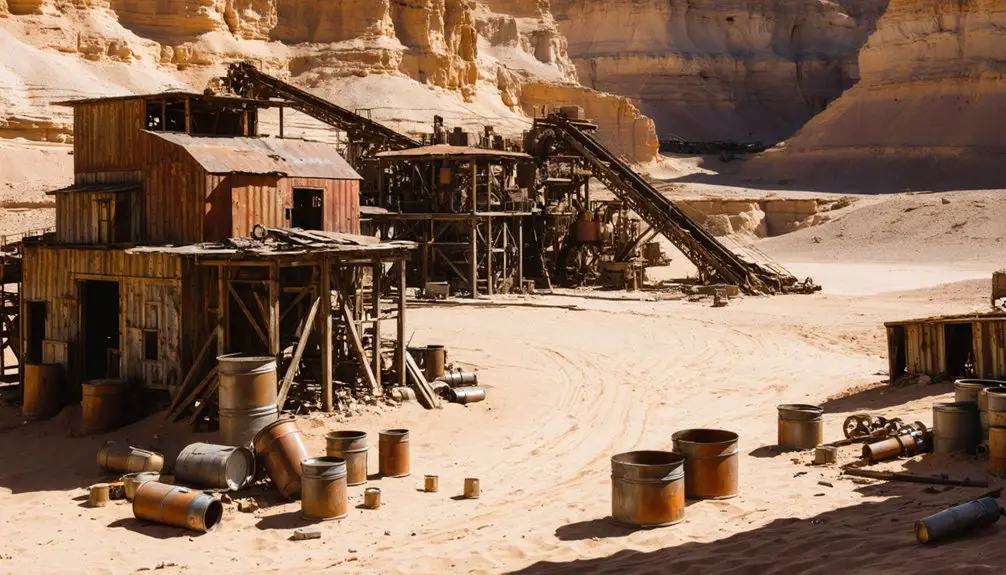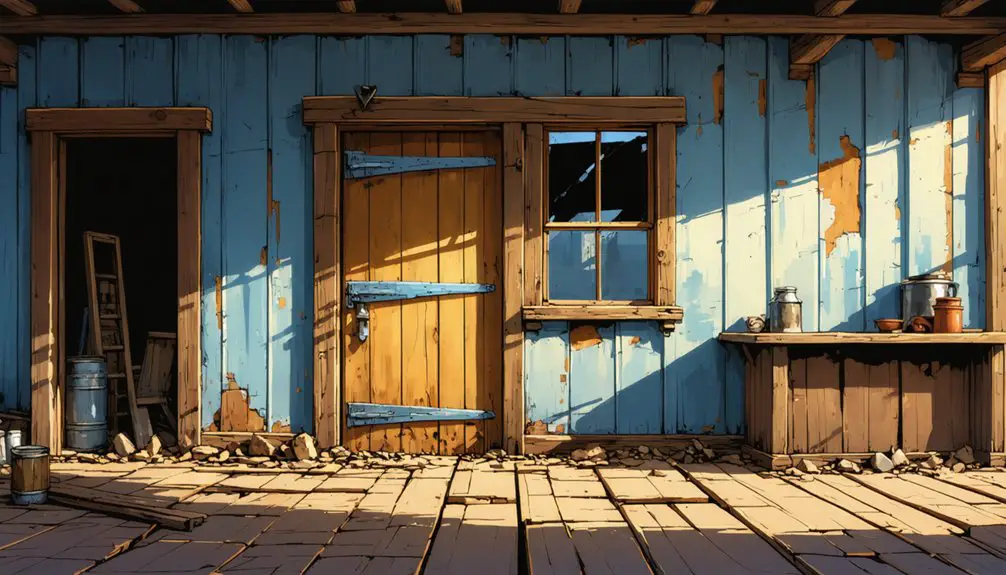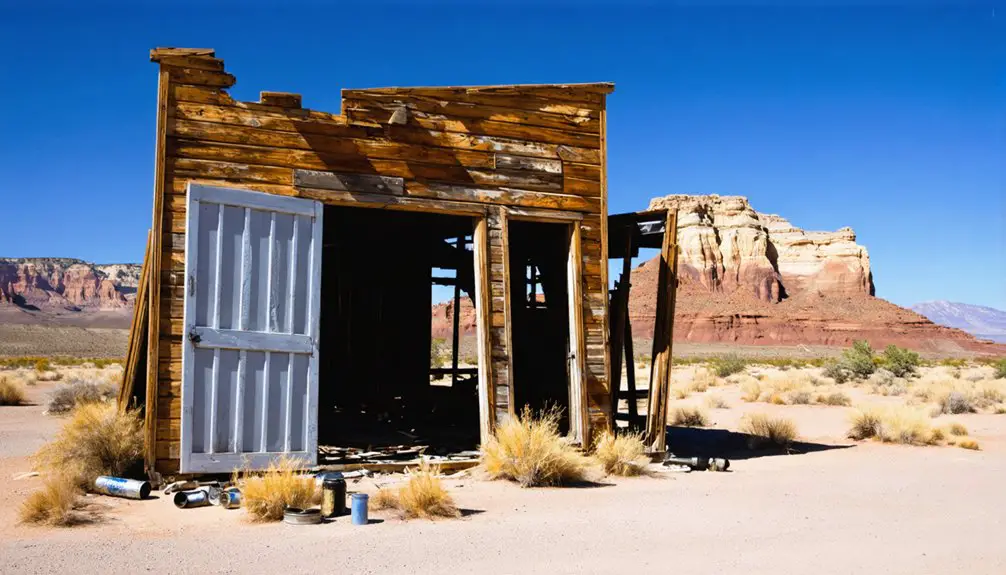You’ll find Gold Butte’s ghost town ruins 120 miles northeast of Las Vegas, where a 1905 gold discovery sparked a five-year mining boom. The site expanded rapidly to 2,000 residents with infrastructure including a post office, hotel, and stores. By 1910, mining operations yielded $75,000 before the town’s abandonment. Today, the area features ancient petroglyphs, dramatic geological formations, and archaeological remnants that reveal layers of human habitation across millennia.
Key Takeaways
- Gold Butte was a mining town established in 1905 after gold discovery, reaching a peak population of 2,000 before abandonment in 1910.
- The town featured essential infrastructure including a post office, hotel, livery stable, and store by 1906.
- Total gold production was valued at approximately $75,000 before mining operations ceased in December 1910.
- The site now contains remnants of the mining era alongside significant archaeological artifacts, including 12,000-year-old Native American petroglyphs.
- Located in harsh terrain, visitors require high-clearance vehicles and extensive preparation to safely explore the ghost town area.
The Birth of a Mining Town
While the Gold Butte region had long been home to Southern Paiute people and Mormon settlers, its transformation into a mining town began with Daniel Bonelli’s 1873 mica discovery.
The real catalyst for development came in 1905 when gold was discovered, triggering an influx of prospectors who’d transform the landscape with their mining techniques.
You’ll find evidence of their determination in the surviving arrastras, where early settlers crushed ore using flat stones.
The burgeoning town quickly established essential infrastructure – a post office, hotel, livery stable, and store emerged to support the growing population.
Wooden and stone corrals were constructed to accommodate the ranching needs that complemented mining activities.
The site represents a brief but significant moment when prospectors’ dreams of striking it rich converged with the practical demands of frontier living.
Today, the area is protected as part of the Gold Butte National Monument, preserving these historic remnants for future generations.
The ancient petroglyphs scattered throughout the region provide evidence of human activity dating back over 12,000 years.
Life in the Gold Rush Era
Life in Gold Butte reflected the harsh realities of frontier mining settlements, where prospectors traded comfort for the promise of wealth.
You’d find yourself living in crude log structures or makeshift shelters, maneuvering through crowded, unsanitary conditions that challenged even the hardiest settlers.
Daily routines centered around exhausting physical labor – digging, panning, and crushing ore under the scorching Nevada sun.
From dawn to dusk, miners endured backbreaking work, their picks and pans searching relentlessly for gold beneath Nevada’s merciless sun.
After work, you could seek respite in the town’s social venues: saloons and coffee houses offered brief escapes from the grueling lifestyle. Like many Gold Rush towns, the community attracted a mix of miners and gamblers seeking their fortune.
The town’s diverse population included European, Asian, and Latin American immigrants, all pursuing their own versions of the American dream.
While merchants and suppliers prospered, most miners struggled to make ends meet, yet the promise of striking it rich kept the community’s spirit alive.
The transition from individual prospecting to organized operations meant many workers became employees of wealthy mine owners rather than independent fortune seekers.
The Rise and Fall of Gold Butte
Following Daniel Bonelli’s 1873 mica discovery, Gold Butte’s trajectory as a mining settlement began modestly with small mineral shipments in the 1890s before exploding into prominence after the 1905 gold strike.
Like the bustling mining operations that emerged in Butte’s gold camps in 1864, Gold Butte’s mining techniques evolved as prospectors established essential infrastructure including a hotel, livery stable, and store.
The population swelled to 2,000 during peak operations.
The town established a post office in 1906, marking its growing significance as a frontier settlement.
Ancient Petroglyphs and Cultural Heritage
Deep within Gold Butte’s rugged landscape lies one of North America’s most significant collections of ancient petroglyphs, dating back over 12,000 years.
These remarkable carvings, created by ancestors of today’s Moapa and Las Vegas Bands of Paiutes, serve as windows into prehistoric cultural storytelling and archaeological significance. The striking petroglyphs stand out dramatically against the red rock formations that characterize the area. A dedicated team of site stewards monitors and protects these invaluable archaeological treasures.
The area’s rich heritage includes:
- Billboard-style rock art panels stretching up to 90 feet, displaying multiple generations of cultural expression
- Over 2,000 documented archaeological sites featuring rock shelters, middens, and roasting pits up to 25 feet in diameter
- Ancient grinding stones and pottery shards that reveal daily life patterns spanning 3,000 years of continuous habitation
You’ll find these protected treasures throughout Gold Butte’s remote terrain, where modern preservation efforts guarantee these irreplaceable cultural resources endure for future generations.
Natural Wonders and Geological Features
When you explore Gold Butte’s red sandstone formations, you’ll encounter dramatic wind-carved spires and cliffs sculpted over millions of years through erosional processes.
These ancient geological features showcase the area’s complex weathering patterns, with iron oxide staining creating the distinctive red coloration characteristic of desert landscapes. The area’s remarkable geology includes Proterozoic metamorphic rocks that formed deep within Earth’s crust. The monument’s fossil track-sites reveal ancient reptilian footprints dating back over 170 million years.
From the Virgin Mountains’ peaks, you can survey this remarkable terrain where narrow canyons and intricate rock formations provide critical habitats for desert flora and fauna.
Dramatic Red Stone Formations
The dramatic red stone formations of Gold Butte stand as evidence to 190 million years of geological processes.
You’ll find these striking geological formations composed primarily of Aztec Sandstone, where iron oxide creates vibrant crimson to pink hues throughout the landscape.
Wind erosion and chemical weathering have sculpted the red sandstone into extraordinary shapes at sites like Little Finland, also known as Devil’s Fire.
- Explore twisted spires and delicate fins carved by millennia of desert winds
- Discover layered bands revealing ancient fossil dunes in cliff faces
- Witness remarkable features like Devil’s Throat sinkhole and natural arches formed by differential weathering
These formations serve as both natural landmarks and sacred spaces, housing thousands of petroglyphs while providing vital habitat for desert wildlife.
Ancient Wind-Carved Landscapes
Over millions of years, persistent winds have masterfully sculpted Gold Butte’s sandstone formations into an intricate gallery of geological artistry.
You’ll discover smooth, polished surfaces where wind patterns have relentlessly driven sand particles against rock faces, creating unique textures and shapes that define the landscape.
Wind erosion effects are most dramatic in the exposed sandstone domes and hoodoos, where softer rock layers have been stripped away, leaving behind resistant pinnacles and balanced rocks.
As you explore, you’ll notice desert pavements – natural mosaics of tightly packed pebbles created by wind scouring.
The wind’s interaction with water and freeze-thaw cycles has deepened canyons and crevices, while seasonal gusts continuously reshape the dunes.
These geological processes have exposed ancient rock strata, revealing millions of years of Earth’s history in vertical layers.
Virgin Mountains Peak Views
Rising dramatically from the desert floor, Virgin Peak commands attention as the highest point in the Virgin Mountains at 7,946 feet, offering unparalleled geological perspectives across Gold Butte’s wind-carved terrain.
From this prominent vantage point, you’ll witness the complex interplay of ancient Precambrian metamorphic formations and younger sedimentary layers that define the region’s geological character.
- Survey the stark contrast between resistant calcareous cliffs and metamorphic outcrops that create natural panoramic vistas
- Observe the structural shift where the Basin and Range province meets the Colorado Plateau
- Examine the diverse microhabitats formed by elevation changes, from desert basin to high-altitude forests of pinyon pine and white fir
The peak’s strategic position above the Virgin River Depression reveals millions of years of tectonic activity through its exposed rock formations and complex fault systems.
Mining Operations and Economic Impact

Mining operations at Gold Butte began after Daniel Bonelli’s 1873 mica discovery, though significant development didn’t occur until gold’s discovery in 1905 sparked a rush of activity.
The mining techniques employed were primarily small-scale, utilizing arrastras for ore crushing and wagon transport to St. Thomas for processing.
Despite reaching a peak population of 2,000 residents, the district’s economic sustainability proved challenging. Total recorded production reached approximately $75,000 in early 20th century value, derived from gold, mica, magnesite, copper, and zinc extraction.
The Gold Butte Mercantile, Townsite & Mining Co. established formal infrastructure in 1908, including a hotel, store, and livery stable.
However, mining operations largely ceased by December 1910, leading to the town’s abandonment and marking the end of its brief but intense mining era.
Ghost Town Remnants Today
Today’s visitors to Gold Butte ghost town encounter a landscape dominated by weathered remnants of its mining past, including scattered equipment, concrete foundations, and rusted machinery.
The harsh desert environment has reclaimed most of the ghost town architecture, leaving only stark traces of the once-bustling mining community.
Time and sand have erased Gold Butte’s buildings, leaving only whispers of its vibrant mining past in the desert.
Key mining artifacts you’ll discover:
- Rusted ore processing equipment and truck beds scattered across the terrain
- Concrete slabs marking former building foundations and structural footprints
- Historical markers near gravesites of the town’s last residents, including prospectors Bill Garrett and Art Coleman
The site’s isolation preserves its authentic character, while wildlife like gray jackrabbits and protected species now inhabit the ruins.
A single surviving shade tree stands as a living witness to the town’s transformation from mining hub to desert sanctuary.
Notable Characters and Legends

You’ll discover Gold Butte’s most enduring characters in Bill Garrett and Art Coleman, two hardy prospectors who maintained their wooden cabin and welcomed travelers with moonshine hospitality for 40 years after the town’s abandonment.
The area’s rich indigenous heritage emerges through ancient petroglyphs like the mysterious “Falling Man” figure, which holds deep spiritual significance for the Moapa Band of Paiute and Las Vegas Paiute Tribe.
These cultural and historical threads interweave through Gold Butte’s landscape, from early mining operations to the sacred indigenous sites that span over 12,000 years.
Bonelli’s Early Mining Days
The tale of Gold Butte’s early mining days centers on Daniel Bonelli, a Mormon pioneer who discovered vermiculite sheet mica in 1873. His initial mining techniques focused on extracting mica and vermiculite, conducting trial shipments in 1893-1894 before the area’s mining potential was fully realized.
Community dynamics shifted dramatically after Bonelli’s discoveries, leading to these key developments:
- Mormon pioneers and prospectors flocked to the region, establishing early mining claims.
- Transportation networks emerged with mule teams hauling ore to St. Thomas rail spurs.
- Mining operations expanded from mica to include gold, copper, and zinc extraction by 1905.
Though Bonelli’s early mica mining didn’t yield substantial wealth, his discoveries laid the foundation for Gold Butte’s transformation into a bustling mining district with over 40 claims.
Last Prospectors Standing Guard
Among Gold Butte’s most intriguing historical figures, Bill Garrett and Art Coleman emerged as the final human witnesses to its mining legacy.
For over 40 years, these resilient prospectors maintained their wooden home at the abandoned townsite, offering shelter and meals to travelers along the Gold Butte Trail. Their prospector life exemplified rugged independence, as they sustained themselves through small-scale mining, ranching, and hospitality in the harsh desert landscape.
After the mining boom’s decline in 1910, Garrett, a former wild west showman, and Coleman, known for his tall stature, stood as living links to the area’s frontier past.
Until their deaths in 1958 and 1961 respectively, they preserved Gold Butte’s history through their presence, with their graves now marking a tangible connection to the site’s mining heritage.
The Falling Man Mystery
Hidden within Gold Butte National Monument’s rugged terrain, a mysterious petroglyph known as the “Falling Man” captivates researchers and visitors alike. The distinctive figure, positioned high on a cliff wall, holds what appears to be a celestial orb while descending through space. This enigmatic artwork has spawned multiple interpretations about its true meaning.
Key elements of the Falling Man symbolism include:
- Ancient astronomical connections through the bright sphere motif
- Recurring patterns found at two other nearby locations
- Integration with shadow-tracking circles that mark seasonal changes
You’ll find this remarkable petroglyph along a 1.2-mile trail, where it stands as evidence of the area’s rich cultural heritage.
Whether depicting a tragic fall or a spiritual journey, the Falling Man continues to guard its secrets while offering glimpses into ancient desert civilization.
Preservation and Monument Status
Since receiving federal protection in 1998, Gold Butte‘s archaeological treasures and ecological resources have undergone systematic preservation efforts through multiple protective designations.
You’ll find that the site’s cultural preservation accelerated in 2016 when President Obama designated nearly 300,000 acres as a National Monument. This status safeguards thousands of ancient petroglyphs, mining artifacts, and ghost town structures while maintaining your rights to hunt, fish, and access designated trails.
The Bureau of Land Management oversees environmental protection through a dedicated team of specialists, including wildlife biologists and archaeological technicians. They’ve implemented essential measures like closing 42 abandoned mines for public safety.
The monument status also guarantees that traditional tribal collection practices continue while protecting diverse Mojave Desert habitats and wildlife species.
Planning Your Visit to Gold Butte
You’ll find ideal conditions for exploring Gold Butte’s archaeological sites during the cooler months from late October through early April, when temperatures allow for safer hiking and clearer visibility.
To reach the remote ghost town area safely, you’ll need a well-maintained vehicle with adequate fuel, plus essential supplies like water, food, and sun protection for the journey through 300,000 acres of wilderness.
Your visit requires careful planning around weather conditions and road accessibility, as many areas demand 4-wheel drive vehicles and basic survival gear for traversing this expansive monument’s network of historic trails and petroglyphs.
Best Time to Visit
The best time to explore Gold Butte spans from October through April when moderate temperatures create ideal conditions for investigating archaeological sites and petroglyphs.
You’ll find peak opportunities for best seasonal activities and local wildlife viewing during early spring, when wildflowers carpet the desert landscape and temperatures remain comfortable for extended exploration.
- Winter (December-February) offers mild 68°F days ideal for petroglyph photography, though nights can drop below freezing.
- Early spring (March-April) showcases desert wildflowers and provides excellent hiking conditions.
- Late fall (October-November) delivers favorable weather for camping and archaeological site visits.
Avoid summer months (June to mid-September) when temperatures exceed 100°F, making scientific observation and artifact documentation challenging.
Plan your expedition during morning hours to maximize daylight and excellent viewing conditions.
Getting There Safely
Planning a safe expedition to Gold Butte National Monument requires thorough preparation due to its remote desert terrain and limited facilities.
You’ll need a high-clearance or off-road vehicle to navigate the 83-mile Gold Butte Backcountry Byway, as road conditions can be challenging with unpaved surfaces and sandy washes.
Before departing, stock your vehicle with spare tires, tools, and extra fuel. Pack essential supplies including water, food, first aid kit, and navigation equipment, as cell service is unreliable.
GPS devices and detailed maps are vital for traversing the complex network of two-track roads. Inform someone of your travel plans and expected return time.
Stay on designated roads to protect cultural resources and avoid getting stranded in remote areas where rescue response is limited.
Essential Gear Needed
Successful exploration of Gold Butte’s ghost town requires five essential gear categories: hydration supplies, navigation tools, protective clothing, camping equipment, and safety gear.
You’ll need at least one gallon of water per person daily, plus water purification systems for emergencies. In this remote terrain, reliable navigation tools like GPS devices and topographic maps are vital, as cell service is nonexistent.
- Pack an extensive first aid kit equipped for desert-specific injuries and conditions.
- Bring sturdy boots, UV-protective clothing, and high-SPF sunscreen for intense sun exposure.
- Carry a satellite messenger or personal locator beacon for emergency communications.
Your shelter must withstand desert winds, while sleeping bags should accommodate extreme temperature fluctuations.
Remember to pack waste disposal bags and follow Leave No Trace principles to preserve this historic site.
Frequently Asked Questions
Are There Any Dangerous Animals or Snakes to Watch Out For?
You’ll need to watch for three dangerous snake species and large predators. Most wildlife encounters involve Mojave rattlesnakes, mountain lions, and Gila monsters in rocky outcrops and washes.
What Is the Best Time of Year to Visit Gold Butte?
Like a desert bloom awakening, you’ll find the best seasons are March-April and October-early spring, when weather conditions stay mild and welcoming, perfect for exploring ancient petroglyphs and untamed landscapes.
Is Camping Allowed Within the Gold Butte National Monument?
You can camp within Gold Butte for up to 14 days in any 30-day period. Camping regulations require you to stick to primitive, dispersed camping locations along established roads and trails.
Where Is the Nearest Gas Station to Gold Butte?
You’ll find the nearest gas stations in Mesquite, 30 miles west. Given rough road conditions and variable gas prices, it’s essential to fuel up there before heading into the remote area.
Are Permits Required for Photography or Drone Use in Gold Butte?
You don’t need permits for casual photography, but commercial shoots may require BLM authorization. For drone use, you’ll need permits for commercial flights while following FAA regulations for recreational flying.
References
- https://www.youtube.com/watch?v=U_zgUd957iA
- https://en.wikipedia.org/wiki/Gold_Butte
- https://www.nvexpeditions.com/clark/goldbutte.php
- https://nvtami.com/2024/02/25/gold-butte-national-monument/
- https://www.friendsofgoldbutte.org/about-gold-butte/
- https://npshistory.com/publications/blm/gold-butte/ann-mgr-rpt-2018.pdf
- https://www.conservationatlas.org/blog/gold-butte-national-monument-lessons-learned-from-a-local-advocate2017
- https://www.jimwitkowski.com/blog/wpa-legacy-the-historic-cattle-dam-of-gold-butte/
- https://www.sfgate.com/travel/article/california-gold-rush-town-nevada-city-18448477.php
- https://gonevadacounty.com/gold-mining-history-in-nevada-county/



